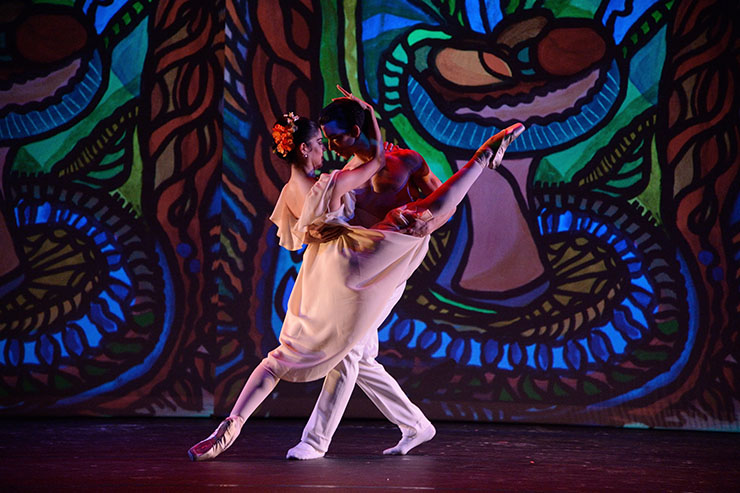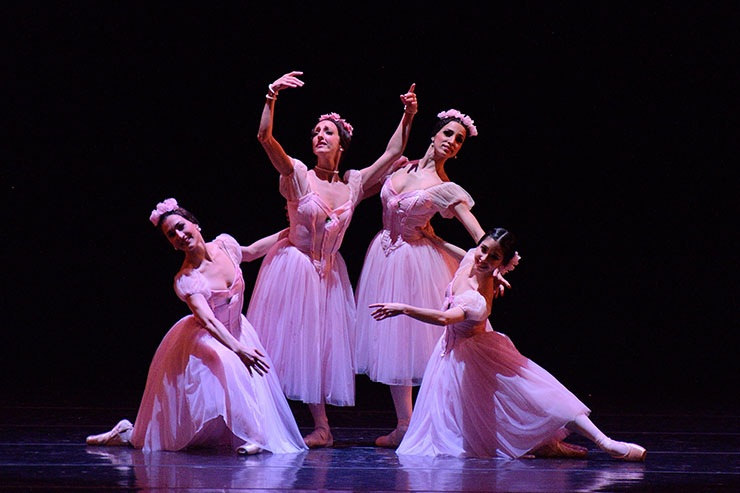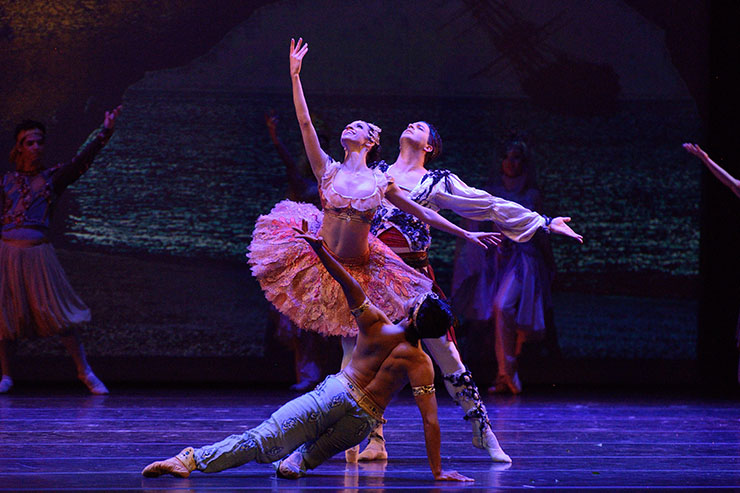
It was almost jarring to the modern eyes to see a classical ballet tableau as the curtain opened on the Cuban Classical Ballet performance at the Miami-Dade Auditorium, in a presentation that was the second night of a two-night performance (one was on Friday, June 9 at the Colony Theater; the other at MDA on Saturday, June 10). Not often does one see true classical dance with beauty and elegance — and technique in the present day. In this performance, it was a pleasure to see dancers that were aware of how their arms moved, the way they executed technique, how they stepped into positions and used their total facility in an artistic and skilled manner. Today, when we are inundated with the styles so prevalent in So You Think You Can Dance, with fast explosive movement that almost any good mover can do, external emotion and many tricks, it is rewarding to see absolute technique and skill. Not every dancer can execute it. Making it look effortless is an even bigger challenge.
First on the program of traditional classical repertory was “Les Sylphides,” a plotless series of divertissements based on the Michael Fokine choreographic version from 1909. The single male role is the poet, and an ensemble of 16 girls and three principals are the sylphs wearing white, long romantic tutus. It is a simple and lovely romantic reverie danced to familiar Chopin compositions in a moonlit setting. In CCB, the excerpted ballet and, oftentimes, re-choreographed version of “Sylphides” was performed by only the poet and the three principals who danced almost the entire ballet. Trisha Carter and Masiel Alonso were the essence of artistry as they represented the ensemble roles. Mayrel Martinez was not an overly dramatic performer who executed the steps clearly and cleanly in the lead pas de deux with the elegant Arionel Vargas. The ballet was arranged and edited to flow smoothly, but a program note would have educated and, perhaps, inspired the audience to do a little investigative research on a work that is such a tradition in the classical ballet repertory.

An addition to the program was the showcase, “Flames of Paris” pas de deux performed by a subtly charming, if sometimes unsteady, Gretel Batista and a dynamic and confident, Francois Llorente. “Flames” is a pas that is done at world wide galas and competitions to show off technical prowess and exuberance. The couple was fun to watch, and Llorente certainly delivered all that was expected in his complex jumps and secure turns.
Offering an opportunity for some of the less mature dancers to perform, was “Habaneras” allowing the dancers to explore expressiveness and artistry while maintaining simple choreography and clear intent. The lone male figure, sensuous Jorge Oscar Sanchez, had an intimate moment with a young girl before slipping away. Meanwhile, the girls continued their romantic dreams. A bold set by Rogello Quintana and Jesus Castanar based on original painting by Amelia Pelaez was a splash of dynamic color against the whimsical dancers.
In 1845, the four greatest ballerinas of their time came together to perform in “Le Pas de Quatre.” This was a stylistic showcase for the four ladies of the present: Lorena Feijoo, former ballerina of San Francisco Ballet and familiar dancer of the CCB, as the mature Marie Taglioni, Marize Fumero as the young Lucille Grahn, Venus Villa as the flowery Fanny Cerrito and Manuela Navarro as the austere Carlotta Grisi. Representing ballerinas of the 1800s, it is necessary to, not only deliver the style of the period, but to embody the spirit of that particular dancer. Grahn was known for her buoyant jumps, Taglioni her elegance and supreme ownership of her position, Cerito was colorful and exuberant and Grisi was technically secure. Variations in choreography aside (I am more familiar with the Anton Dolin version of Ballets Russes) more character development in Grahn and Grisi would have made the identities richer. Still, it was lovely to see a ballet that is rarely done.

Part II took us to exotic lands, gypsies, beautiful women, and the virile men who are enamored by them in “Le Corsaire Suite.” One excellent dancer out doing the next, rousing gypsies and exuberant character dances kept the audience ignited and enthused as the story unfolded. Rich backdrops provided encompassing settings, especially in the rose garden. Jesus Sanfield was a flamboyant and funny Pasha, as he tried to add Fumero and Villa to his collection of wives. Fumero was in her element, delivering the traditional “Corsaire pas” with aplomb, style and technical virtuosity. Villa was sprightly and charming. The men stole the show. Vargas, a dynamic Sanchez, whippersnapper, Rodrigo Almarales and Llorente, in a role that was as much acting as technique, carried this tale of slavery and love into new adventures.
Late August into September sees the Cuban Classical Ballet hosting the XXII International Ballet Festival of Miami 2017 with performances from dancers from all over the world. A special performance by CCB will be Sept. 14, 16 and 17. Venues will be announced. Stay tuned at www.cubanclassicalballet.org.
 MAIN MENU
MAIN MENU

